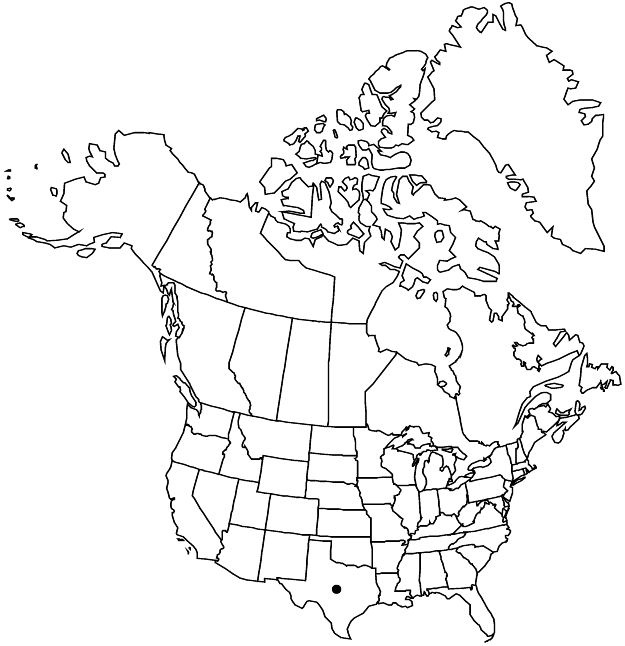Difference between revisions of "Passiflora foetida var. gossypiifolia"
Trans. Linn. Soc. London 27: 631. 1871.
FNA>Volume Importer |
FNA>Volume Importer |
||
| Line 29: | Line 29: | ||
|habitat=Woodlands and shrublands, usually subtropical, in moist to dry, loamy to sandy soil, 10–200(–300) m | |habitat=Woodlands and shrublands, usually subtropical, in moist to dry, loamy to sandy soil, 10–200(–300) m | ||
|distribution=Tex.;Mexico;West Indies;South America. | |distribution=Tex.;Mexico;West Indies;South America. | ||
| − | |discussion=<p>Variety gossypiifolia is perhaps the most naturally widespread member of this diverse species and exhibits a large amount of vegetative morphological variation as well (E. P. Killip 1938). Varieties of Passiflora foetida and some related species share the common features of mature leaves that are pungent when bruised and fruits that are green to yellow. The taxonomy of this species and other members of sect. Dysosmia is complicated and requires much more research.</p><!-- | + | |discussion=<p>Variety gossypiifolia is perhaps the most naturally widespread member of this diverse species and exhibits a large amount of vegetative morphological variation as well (E. P. Killip 1938). Varieties of <i>Passiflora foetida</i> and some related species share the common features of mature leaves that are pungent when bruised and fruits that are green to yellow. The taxonomy of this species and other members of sect. Dysosmia is complicated and requires much more research.</p><!-- |
| − | --><p>Plants with small, orange fruit, possibly of var. hispida (de Candolle ex Triana & Planchon) Killip ex Gleason, recently have been found naturalized in the city of Coconut Creek, Broward County, Florida, although efforts to eradicate it are being implemented.</p><!-- | + | --><p>Plants with small, orange fruit, possibly of <i></i>var.<i> hispida</i> (de Candolle ex Triana & Planchon) Killip ex Gleason, recently have been found naturalized in the city of Coconut Creek, Broward County, Florida, although efforts to eradicate it are being implemented.</p><!-- |
| − | --><p>Passiflora foetida is suspected of insectivory. The glandular trichomes have the ability to trap and kill small invertebrates, with the potential for enzymatic absorption (T. R. Radhamani et al. 1995).</p> | + | --><p><i>Passiflora foetida</i> is suspected of insectivory. The glandular trichomes have the ability to trap and kill small invertebrates, with the potential for enzymatic absorption (T. R. Radhamani et al. 1995).</p> |
|tables= | |tables= | ||
|references= | |references= | ||
| Line 54: | Line 54: | ||
|publication year=1871 | |publication year=1871 | ||
|special status=Weedy | |special status=Weedy | ||
| − | |source xml=https://jpend@bitbucket.org/aafc-mbb/fna-data-curation.git/src/ | + | |source xml=https://jpend@bitbucket.org/aafc-mbb/fna-data-curation.git/src/8f726806613d60c220dc4493de13607dd3150896/coarse_grained_fna_xml/V6/V6_322.xml |
|genus=Passiflora | |genus=Passiflora | ||
|species=Passiflora foetida | |species=Passiflora foetida | ||
Revision as of 17:47, 18 September 2019
Stems terete, densely hairy. Leaves pungent, densely hairy, glandular-ciliate; stipules pectinate, 2–5 × 1–3 mm, with glandular bristles or hairs; petiole with glandular bristles or hairs; blade roughly symmetric, 3–5(–8) × 2.5–5.5(–7) cm, moderately to deeply 3-lobed, middle lobe as long as or longer than lateral lobes, margins serrate to nearly entire; abaxial fine veins weakly to moderately raised, abaxial nectaries absent. Floral bracts pinnatifid, 20–30 × 20–25 mm, margins serrate to nearly entire, with glandular bristles or hairs. Flowers: floral tube cuplike, 3–5 mm deep; sepals white, 15–25 × 5–7 mm; petals white, 15–23 × 5–7 mm; corona filament whorls 5–6, outer 2 whorls purple to violet, linear, terete to transversely compressed, 10–17 mm. Berries green to yellow-green, ovoid to subglobose, 15–25 × 15–25 mm.
Phenology: Flowering May–Aug(–Dec).
Habitat: Woodlands and shrublands, usually subtropical, in moist to dry, loamy to sandy soil, 10–200(–300) m
Distribution

Tex., Mexico, West Indies, South America.
Discussion
Variety gossypiifolia is perhaps the most naturally widespread member of this diverse species and exhibits a large amount of vegetative morphological variation as well (E. P. Killip 1938). Varieties of Passiflora foetida and some related species share the common features of mature leaves that are pungent when bruised and fruits that are green to yellow. The taxonomy of this species and other members of sect. Dysosmia is complicated and requires much more research.
Plants with small, orange fruit, possibly of var. hispida (de Candolle ex Triana & Planchon) Killip ex Gleason, recently have been found naturalized in the city of Coconut Creek, Broward County, Florida, although efforts to eradicate it are being implemented.
Passiflora foetida is suspected of insectivory. The glandular trichomes have the ability to trap and kill small invertebrates, with the potential for enzymatic absorption (T. R. Radhamani et al. 1995).
Selected References
None.